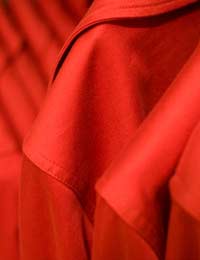Recognising Fake Designer Clothing

How is it that so many people you see can afford designer clothes? Wherever you go, it seems, someone's flaunting Prada or Marc Jacobs, D&G, Versace, or any one of the multitude of designers who sell their clothing.
But real designer clothing is expensive, generally beyond the range of most people. So how do they do it? The answer, of course, is that the vast majority of them are wearing fakes, counterfeits that sell for much, much less than the real thing. In many cases the wearers know they're dressed in knock offs, and really don't care. But some of them will have been genuinely duped, thinking they've found a bargain on something normally far out of their price range.
So how do you tell the real from the counterfeit? With so many designer labels around it's impossible to go through them all, especially as the fakers keep learning and changing what they do. But there are some guidelines about differences that will stand you in good stead.
Guidelines
The biggest difference, always, is the quality of the material used in the item. It doesn't matter whether it's a short or a dress, designers will use top quality materials; it's a big part of what sets them apart from shops on the High Street.
Before you even think of buying something dubious, examine the real thing. Feel the material, then go to the possible fake. If it seems thinner and cheaper, or even coarser and thicker, you know it's not real.
The stitching on a designer item will always be superior. The cotton will match the fabric, and in most instances you shouldn't even be able to see it - after all, that's what design is all about. Examine the inside of the garment. Where you can see it, the stitching should be tight and even, something you simply won't find on the fakes, where quality is far less important than quantity.
Don't believe that just because it has tags, it must be real. Counterfeiters can fake tags as easily as garments. At one time it stood as a guarantee that the item was real, but that no longer applies.
The bigger the name, the more likely it is to be faked. After all, the counterfeiters want to shift big numbers of units, so there's little point in counterfeiting barely-known designers whose clothes don't sell well.
Use Common Sense
How likely is it that you'd find real Versace or Prada on a market stall? Would real, brand-new designer clothing go for a fraction of the retail price? Of course not! It might be tempting to think you've found a wonderful bargain, but if you think clearly for a moment you'll realise that it's all too good to be true.
If you're buying from a website, make sure there are real contact details (phone number and physical address). If not, that should raise a red flag immediately. On online auction sites (one of the main places to find designer fakes), check the seller's feedback carefully before bidding, and pay with a credit card or PayPal - if the item proves not to be the real thing, you then have recourse to get your money back.
- The Most Counterfeited Brand
- Learn About Counterfeit Coins
- Counterfeit Sports Items
- Counterfeit Outdoor Jackets - is it Fake or Authentic?
- Identifying Fake Sports Clothing
- Fake Designer Underwear
- Sorting Fakes From Real Jeans Labels
- Counterfeiting and Men's Clothing
- How Fashion Designers are Combatting Fakes
- Fake Hip-Hop Clothing and How to Identify it


Re: Counterfeit Cigarettes On The Market
In the uk Richmond Original king size or super kings If it says Richmond blue FAKE…
Re: Your Rights As A Consumer - How To Make A Complaint
Hi, I purchased a pair motorcycle pants form an online company Custom Jacket Co, they registered at…
Re: Consumer Rights - What Can You Do If You've Purchased Counterfeit Goods?
Was sold counterfeit jewellery items although stated in the ad that it…
Re: Consumer Rights - What Can You Do If You've Purchased Counterfeit Goods?
I recently bought five Momo carbon fibre steering wheels off a person on…
Re: Consumer Rights - What Can You Do If You've Purchased Counterfeit Goods?
I bought about 70 goods from 5 star costemics on May 26, 2020, and when I…
Re: Counterfeit Cigarettes On The Market
I have been buying what I think is Richmond Blue from a local shop at full market price but they keep going out, are…
Re: Counterfeit Cigarettes On The Market
Started using a cigarette case as new packs horrible, noticed varying filter lengths Marlboro red from local shop,…
Re: Counterfeit Cigarettes On The Market
If governments around the world didn't keep restricting tobacco, and making prices become insanely high, then there…
Re: Counterfeit Cigarettes On The Market
Bought Sterling reds in Tenerife from a shop stating 100% genuine. Sterling logo on cigarette is red; when I buy in UK…
Re: Counterfeit Cigarettes On The Market
I have purchase a pack of the fake cigarettes. They taste bad plus I felt kind of dizzy afterwardso. They are all over…